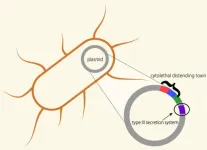(Press-News.org) Move more, quit smoking, lose weight: great resolutions, hard to keep. But does it get easier if there is a financial incentive in return? According to research by Radboud University and others, it can be an effective tool, although there are still some obstacles. They presented their findings this week in Economisch Statistische Berichten (ESB).
Some lifestyle interventions are more effective than others, but in general, financial incentives are a ‘powerful tool to help reduce health inequalities in the Netherlands’, says Koen van der Swaluw of Radboud University. Despite knowing more and more about the effectiveness of financial incentives to promote lifestyle, they are still relatively little used. Health insurer ASR scrapped a reward programme for healthy behaviour earlier this year. Together with colleagues Stefan Lipman (Erasmus University) and David de Buisonjé (Delft University of Technology, Leiden University), Van der Swaluw mapped the barriers to introducing rewards for healthy behaviour.
'Around financial incentives, there are often objections about the limited long-term effects: will someone continue the changed behaviour once the incentive ends? There are opportunities for follow-up research there,' says van der Swaluw. ‘For instance, there have been successful programmes to discourage smoking during pregnancy, programmes that have long-term effects’.
Not opera, but football
ASR changed its rewards programme because mainly active people used it. 'But if you align the rewards with the desires of people who are not yet active, you probably have a better chance. What we see in literature reviews is that rewards do not always match the recipient. Simply put: don't give away tickets to the opera, for example, but to football matches.' Finally, there are often concerns about the cost of financial incentives.
Van der Swaluw and colleagues suggest that financial incentives - like curative care - could be reimbursed from collective health insurance if they prove cost-effective on the basis of a social cost-benefit analysis. Employers could also play a role in encouraging healthy behaviour and assume (part of) the costs.
No panacea
Although the effectiveness of incentives is becoming increasingly clear, they should not be seen as a panacea, according to the researchers. 'In no way are they a replacement for policies aimed at structural aspects of unhealthy behaviour, such as exercise or food supply in the neighbourhood someone lives in, poverty, cultural influences and national or international laws and regulations. Healthy behaviour is and remains a consequence of an interplay of individual behaviour and environmental influences.'
Follow-up research
From November 2024, van der Swaluw and colleagues will start the SPRINTS (‘Sports Pricing Research to INcrease Sport Participation’) project in collaboration with the HAN University of Applied Sciences, among others, investigating how prices influence sports and exercise participation. They previously published a study on rewards for smoking cessation, which appeared in BMC Public Health.
END
Financial incentive encourages healthiness: why isn't it used more often?
2024-10-17
ELSE PRESS RELEASES FROM THIS DATE:
People sympathize with bullied AI bots
2024-10-17
In an Imperial College London study, humans displayed sympathy towards and protected AI bots who were excluded from playtime.
The researchers say the study, which used a virtual ball game, highlights humans' tendency to treat AI agents as social beings – an inclination that should be considered when designing AI bots.
The study is published in Human Behavior and Emerging Technologies.
Lead author Jianan Zhou, from Imperial’s Dyson School of Design Engineering, said: “This is a unique insight into how humans interact ...
Providencia rustigianii has virulence gene akin to Salmonella’s
2024-10-17
Salmonella and E. coli are well-known bacteria that cause food poisoning, but less understood are species of Providencia, another causative agent of serious symptoms. Providencia rustigianii, isolated from pediatric gastroenteritis patients, has now undergone whole genome sequencing by a research team led by Osaka Metropolitan University Professor Shinji Yamasaki of the Graduate School of Veterinary Science and the Osaka International Research Center for Infectious Diseases.
Members of the team had previously reported that P. rustigianii carries a cytolethal distending toxin virulence gene on its plasmid. Elimination of this gene did not ...
Ozempic (and similar medications) may be the new treatment for opioid and alcohol use disorder
2024-10-17
A new study published in the scientific journal Addiction has found that people with opioid or alcohol use disorder (OUD, AUD) who take Ozempic or similar medications to treat diabetic/weight-related conditions appear to have a 40% lower rate of opioid overdose and a 50% lower rate of alcohol intoxication than people with OUD and AUD who do not take Ozempic or similar medications.
Ozempic is one of several medications, called glucagon-like peptide-1 receptor agonists or GLP-1 RAs, that are prescribed to treat diabetes, obesity, and other weight-related medical conditions. The medications interact with ...
Artificial nests boost penguin breeding success, but there’s no one-size-fits-all design
2024-10-17
Artificial nests can boost the breeding success of endangered African penguins, but different designs are more effective at different colonies according to a new study by an international team of researchers from South Africa and the UK. The findings are published in the British Ecological Society journal, Ecological Solutions and Evidence.
A new study, led by researchers at Nelson Mandela University, which monitored the breeding success of African penguins for 12 years across South Africa has found that artificial ...
Study: Pediatric healthcare facilities need more staff dedicated to infection prevention
2024-10-17
Arlington, Va. — October 17, 2024 — A new paper published today in the American Journal of Infection Control (AJIC) describes efforts at a major children’s hospital to assess and fulfill its staffing needs for infection prevention and control, highlighting the challenges of allocating sufficient resources to this important role. Infection preventionists (IPs) at Boston Children’s Hospital found that conventional methods for calculating the number of staff for these roles do not accurately reflect the current needs of healthcare systems or the specific needs of a pediatric ...
Marine experts challenge reliability of vessel strike prediction models
2024-10-17
A new study has raised questions about current approaches to predicting the risk of vessel strikes on whales.
Led by researchers at Heriot-Watt University in Edinburgh, Scotland, an international team of scientists compared eight models currently in place to assess and forecast the risk of ships colliding with whales. The study reveals notable inconsistencies in the results across the different models.
Most reports of vessel collisions involve large whales but all species can be affected. Globally, strikes are under-reported and can often go undetected, particularly when they involve large vessels. Collisions can result in animals being injured or killed, and vessels ...
USC study finds link between PFAS, kidney function and gut health
2024-10-17
New research has revealed that the connection between per- and polyfluoroalkyl substances, or PFAS, and kidney damage may be tied to dysregulation of the gut microbiome, which is made up of bacteria and other microorganisms that live in the digestive tract.
PFAS are manufactured chemicals used in a wide range of products, including everything from furniture to food packaging. They are often called “forever chemicals” because once they accumulate in the environment or the human body, they take a very long ...
Compound drought-heatwave events underrecognized in global soils
2024-10-17
Soil is essential for life and plays a crucial role in Earth's ecosystem, providing support for plant roots and hosting countless microorganisms. In a warming world, it is important to understand how soil hydrothermal conditions, particularly dry-hot extremes, have changed already and how they will respond to further warming.
In a study published in PNAS, researchers led by Prof. ZHANG Yunlin from the Nanjing Institute of Geography and Limnology of the Chinese Academy of Sciences, along with collaborators from the Helmholtz Centre for Environmental Research (UFZ) and Bangor University, have quantified global soil compound drought-heatwave (SCDHW) ...
Pursuing the biological mechanisms and diversity of marine life through international collaboration
2024-10-17
The Okinawa Institute of Science and Technology (OIST) and France’s National Centre for Scientific Research (CNRS) have signed an agreement to establish the International Research Laboratory “Eco-Evo-Devo of Coral Reef Fish Life Cycle” (IRL EARLY). The ceremony took place on October 7 at the STS Forum in Kyoto, Japan.
Since life began in our oceans, it has diversified into a wide variety of different organisms. However, the true extent of marine diversity remains unknown, as do many species and their ecologies. Investigating the biological mechanisms of marine life can not only provide a deeper understanding of the life cycles and evolution of these organisms, it ...
Europe’s First ever conference for minoritised life scientists set for Spring 2025
2024-10-17
A unique group of life science professionals and advocates has come together to launch the Minoritised Life Scientists Future Forum, the first major conference in Europe dedicated to supporting and showcasing the contributions of marginalised and underrepresented communities in the life sciences.
Taking place at the ICC Birmingham from 31 March to 2 April 2025, the Future Forum will offer over 200 hours of inspiring talks, workshops, and mentoring sessions. The event is designed for life scientists at all career stages from undergraduate students to early-career ...



